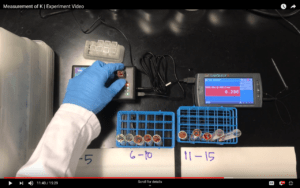Keep Teaching: How Do You Teach a Laboratory Course Remotely?


Blog posts in the Keep Teaching series are written by CTL faculty and faculty from around the Institute to offer advice and inspiration during the COVID-19 disruption. For official Institute academic continuity resources, visit this page. You will also find more teaching and learning tips on the CTL Keep Teaching site.
Guest Blogger Dr. Mike Evans
First-Year Chemistry Laboratory Coordinator
If you had asked me the title question before March 2020, my immediate answer would have been: “you don’t!” And yet, here we are. In about two and a half weeks, I’ve had to convert three introductory chemistry lab courses into fully online offerings. As daunting as that prospect was, one of the first things I did after the news broke that Georgia Tech was moving to remote instruction was to stop, take a breath, and remember that in fact I had already thought a lot about helping students learn on their own outside of lab, even before coronavirus came around.
My laboratory courses in the First-year Chemistry Program are very large. The vast majority of direct instruction happens through graduate or undergraduate teaching assistants. Because I’m one instructor among thousands of students and because I believe students learn only when they engage deeply with experiments on their own time, I’ve been providing students with digital resources since I started teaching these courses. This work has paid off immensely over the past couple of weeks. Although I still feel a great amount of discomfort at being unable to engage with students face-to-face in the laboratory, I can at least take solace in the digital resources I’ve been able to put together.
Valuable Resources and Materials
One of my most important pieces of “technology” for teaching, even now, is the laboratory manual. I tell my remote students to start by reading through the experimental protocol in the lab manual as if they were going to complete the experiment. Protocols include background information and theory, safety information, the experimental procedure, and guidelines for calculations or “workup” of experimental data. Reading and understanding the protocol can easily get a student 75% of the way to success.
Even so, I feel compelled to offer additional resources to students because the introductory chemistry laboratory can be an intimidating place. So, protocols are supplemented by a few different types of videos: Introduction and Theory, which expand on background information in the manual; Technique Tutorials, which are filmed in the lab and focus on specific techniques; and Laboratory Tips, which are also filmed in the lab and point out important things to keep in mind during experiments. With the shift to remote instruction, I have also created a few Experiment Videos, which depict me completing the full experiment in the lab.
 Assignments and Activities
Assignments and Activities
As my lab courses resume in a fully online format, these resources are shifting from supplemental to crucial. Rather than just helping students be more at ease, they are now the only points of contact between students and the laboratory space. I now combine them with a bit of Excel wizardry to supply students with randomized experimental data after they have built familiarity with the experiment through the protocol and videos. Although the system isn’t perfect, my hope is that these resources and the amazing imaginations of Georgia Tech students will help carry them through lab reports successfully.
I’ve also had to adapt some assignments that were specifically designed to be used during experiments. Students receive a Technique and Safety score for each experiment based on the precision, accuracy, and safety of their operations. What on earth does this look like in a remote instruction situation? Rather than scrapping the score completely, I decided to ask students to dig into either technique or safety in more detail than they usually would be able to, given the time demands of an in-person lab section. For example, one experiment in CHEM 1211K and 1310 uses several flammable solvents. As a Technique and Safety assignment, I ask students to examine the correlation between their flash points and boiling points. The correlation is rooted in vapor pressure, which also happens to be a thematic concept in the experiment.
All of this said, like so many instructors right now, I am still very dissatisfied with my approach. I was only able to record three of five Experiment Videos I needed to get done. Student work on a timed lab quiz sits unscanned and lonely in my office, and how I’m going to deal with the second lab quiz (scheduled in three weeks) is still up in the air. I know that modified assignments will place strain on students who might be struggling with housing, family, or health issues. All I can hope for is that the resources I’ve put together will help students continue to see value in thinking about the chemistry lab, even as access to the physical lab space becomes impossible.
Lessons Learned So Far
A few general lessons learned while moving my lab courses to remote instruction:
- Think about what you’ve already made. Maybe it’s not videos, but maybe it’s a sample data spreadsheet for a student that missed lab. Maybe it’s more detailed guidelines for a part of an experiment that you hastily put together in Word a few years ago. Who knows? Take some time to think about what you’ve done in the past and how it might fit into your revised course. That one-off spreadsheet could become a centerpiece of your remote lab course.
- Encourage students to embrace imagination. Expert scientists know that when reading through an experimental protocol, conceptualization and visualization are key. An abrupt shift to remote instruction is a nice opportunity to impart this lesson on students. In the absence of video, imagination is the next best thing!
- Be kind to yourself. We all have limited resources and energy to work right now, and that includes students andinstructors. If something doesn’t get done or your vision doesn’t quite get realized, don’t worry about it! Keep in mind that whatever you do put together is likely to make the next iteration of the course even better, whether it’s in person or online.




